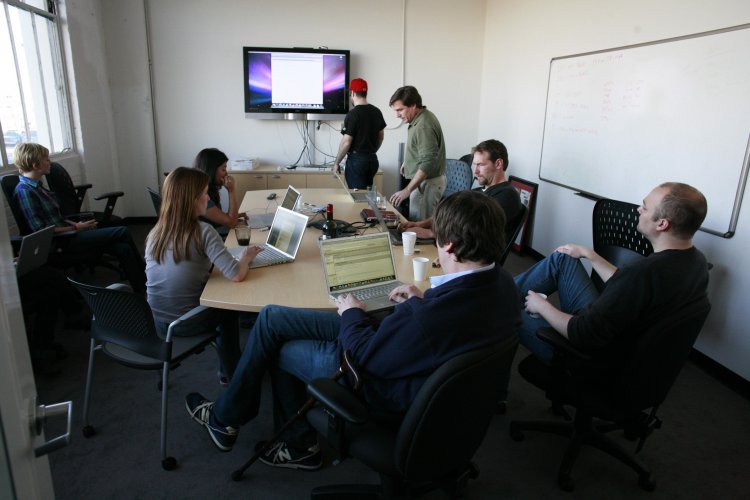Learning to Love Creative Criticism
Jon Kolko, Author, Creative Clarity

Creativity is fundamental to driving the market. It's no longer a word used to describe aesthetics or the "icing on the cake"; creativity is a required competency for organizations who seek to identify new market opportunities, define new ways of running their business, and ship innovative products and services. But the creative process, and creative people, can be frustrating. The process is messy and organic, and the people are emotional and eccentric. Often, conservative companies who have established ways of doing and thinking have trouble attracting and retaining creative talent, who feel stifled by regimented processes, rules, and a hierarchical culture of consensus.
It's not easy to shift that perspective, but there's one approach that is fundamental to evolving an established culture to be more creative: institutionalizing an ongoing process of critique. Critique is a unique form of meeting, one that's been historically found in fields of art and design. We can borrow this approach to help our organizations be more creative, better handle the ambiguity of ill-defined business problems, and develop innovative products and services.
How does a critique work?
A critique involves presenting an artifact to a team, hearing negative criticism about the artifact, and selectively incorporating that criticism into a next iteration of the artifact. More specifically,
- A small group gathers, and an artifact is displayed, either printed out and pinned on the wall, or projected on the screen. An artifact can be a business plan, a diagram of an idea, a spreadsheet, a set of screens, a product requirements document, and so-on. The group musts be small enough to huddle in close and see the material clearly.
- The people who made the work describe it, but don't rationalize or justify it; they present it objectively to ensure comprehension.
- The group describes their reactions to it, explicitly describing problems and offering solutions.
- The people who made the work don't defend their work or explain their decisions. They clarify and answer questions, but otherwise, they are silent and take notes.
- When the meeting is over, the team iterates on the work, selectively making changes based on the feedback, and the process begins again.
Why is a critique useful?
A critique requires that a team has made an artifact. This means that teams aren't just talking about ideas – they are making lasting, tangible representations of those ideas. Because an artifact is tangible, it says "I mean this, not that" and acts as a commitment. It forces the team to take a stance.
A culture of criticism signals that it's OK to present incomplete, in-progress work, and the company recognizes that ideas take time to formulate and come to fruition through exploration. This means that employees can experiment, because there's room to iterate, and that experimentation doesn't have to always succeed.
For critique to work effectively, a team needs to both give and receive criticism, and that means that the team has established trust. In a successful critique, an idea can be shredded, but the people who were developing the idea walk away excited and empowered to refine it. Critique is aimed at the artifact, not the person who made it, and this helps build a collaborative environment.
And, a critique indicates that individuals are empowered to selectively address or ignore feedback. Just because someone in the room with a higher title or more authority made a suggestion, it isn't a mandate for change. Criticism is considered, and the creator can embrace that criticism or reject it. The creator has some degree of creative authority over what is made: a critique is not design by committee.
How can critique become part of a corporate culture?
It's not easy to shift a conservative or staid culture. But to begin embracing the creative process and introduce a culture that embraces critique,
- Lead by example. As you develop strategy and pursue executive-level mandates, present your work as incomplete, embed it in artifacts and not just talk, and hold regular critiques where you follow the rules - don't defend your ideas as you solicit and receive negative criticism.
- Encourage leaders in typically “non-creative” roles, such as operations, project management, or finance, to hold critique in their teams. Indicate that creativity isn't something special reserved for designers and developers - that it's something that acts as a foundation for the entire company.
- Publicly recognize and celebrate ideas that are in flux and in the iteration process, rather than final "complete" accomplishments. By highlighting achievements that are in process, you'll send a signal that ideation is encouraged, and that the process is as important as the outcome.
Critique isn't a silver bullet for creativity, but it's one of the most important aspects of a creative process, and it's a structure that creative people thrive within. Introduce critique into your corporation, and watch your teams iterate faster, work more collaboratively, and develop more innovative solutions to complex problems.
About the Author
Jon Kolko is the author of Creative Clarity, Partner at Modernist Studio, and the Founder of Austin Center for Design. Previously the Vice President of Design at Blackboard, he has worked extensively with both startups and Fortune 500 companies. He has been a Professor of Interaction and Industrial Design at the Savannah College of Art and Design, and has taught at the University of Texas at Austin, the Center for Design Studies of Monterrey, Mexico, and Malmö University, Sweden.

















